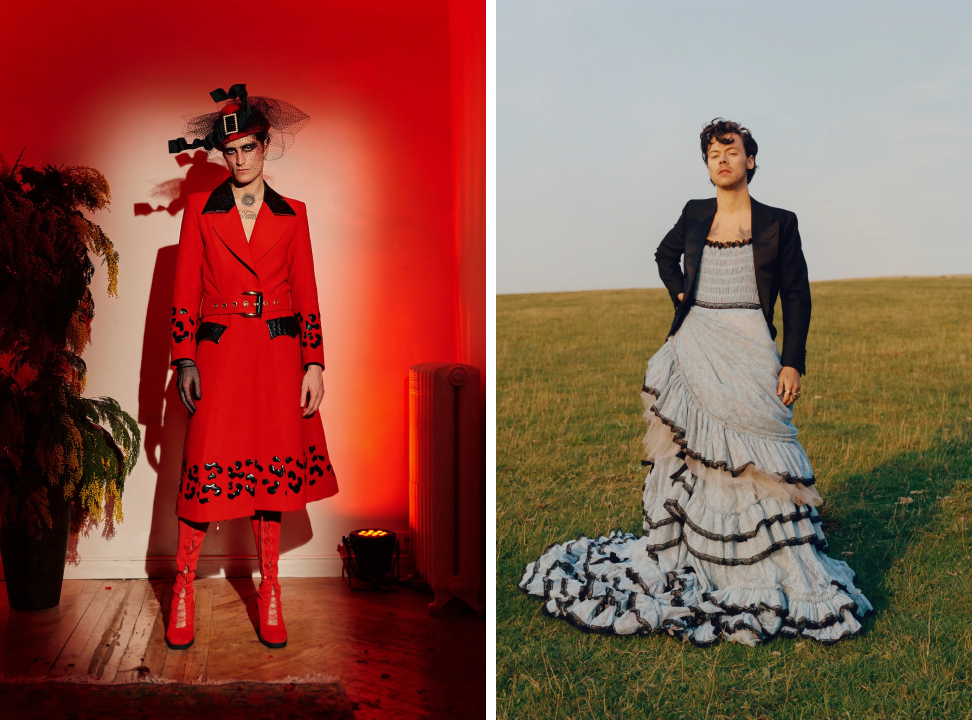Should we blur lines between women's and men's fashion?
At Luxe Talent, as fashion industry experts since 2009, we observe that the lines that used to clearly separate men's and women's clothing are beginning to fade. This phenomenon responds not only to changes in fashion, but also in identity and sociological phenomena; there is an increasing openness to diversity.
In this #LuxeTalentBlog, Paula Sacristán, Marketing Executive, content creator and fashion influencer, takes the reins and tells us what changes designers are making on the catwalks and in their collections.

How can you tell if a garment is for men or for women?
Historically, clothes have been labelled according to the characteristics associated with what is masculine and feminine. Due to the physiognomy and aesthetic preferences that were understood to be intrinsic to each sex. The rise of unisex clothing challenges the traditional distinctions between men's and women's fashion. Aesthetically, they can share many designs, and bodies are less different than we thought, especially in casual and oversized clothing.
Types of Clothing Lines
In the past, clothing collections were divided into separate lines for men and women, each with specific design features. Now, we are seeing the rise of “genderless” collections, which defy traditional conventions and seek to create versatile garments that suit all styles and preferences. Well-known brands such as Palomo Spain, Harris Reed and Telfar are already following this path. Their collections respond to aesthetic issues and inspirations, but are not divided between men and women, they just follow the concept that inspires the collection.

Designers' Reasons for Not Differentiating Clothing Lines
Fashion reflects social and cultural evolution, and in an increasingly diverse and inclusive world, for many artists it makes no sense to limit style choices based on gender. The blurring of lines between men's and women's clothing promotes equality and allows people to express their individuality without pre-established restrictions.
Undoubtedly, this is the natural path that society, especially the younger generation, is following. Brands like Wildfang or NotEqual space manufacture their clothes without gender labels.
The growing trend for capsule collections also shows us that the focus is more on aesthetics, inspiration, and the concept of the drop itself than on gender, whether it differentiates between male and female.

Reasons to Maintain Differentiation between men and women
However, some designers argue that some kind of differentiation should be made to help the collections.
Most designers who prefer to stick with the current classification mainly appeal to the cut of the garments themselves, as men's and women's bodies generally have different morphologies.
As we have already mentioned, unisex collections have shown us that basic, oversize and casual garments can be easily shared. Who hasn't taken clothes from their partner or brother?
But the design of certain garments, like a blazer or a pair of trousers, demands a perfect fit and, in ready-to-wear, it would be almost impossible to do so without differentiating between men and women.
But…
In response to this question, some brands prefer to focus on body type (hourglass, straight, inverted triangle…). For them, this classification is more important than the traditional division between men and women. We can find several brands with this proposal in Asos, Savage x Fenty or Good American.
In response to aesthetic issues, some consumers believe that the division should not be between men and women, as in this way we are imposing a specific aesthetic on each sex. These consumers suggest a classification between masculine and feminine styles, without imposing a style on each sex. They advocate for free choice. The debate and demands are growing on social media. No recognized brand has changed its clothing classification yet.
In general, big designers tend to eliminate gender barriers. Others choose a more conservative position with no changes.
It is true, however, that although the classic division between men and women is still widely retained. More and more fashion shows are showing both collections together, and their models are wearing clothes of their own sex and also of the opposite one.

Conclusion
On catwalks, the lines between men and women are blurring. The majority of emerging brands opt for unisex designs. More established maisons still maintain traditional classification but embrace diversity in their models.
Personally, I believe that there is no right answer. Your brand should use the classification that best suits your consumer. As well as the one that best responds to the type of garments that are manufactured, always looking for the best execution, the question is: what does the nature of the garment itself demand?
Regardless of the classification we choose for our collections, we must always understand fashion as a way of expression to tell our story and who we are. Therefore, we shouldn’t impose an aesthetic on either sex. Instead, each person should be able to use fashion as self-expression that represents him/her/them through unisex garments, of his or her own sex or the opposite.
In fashion shows, brands bet on diversity. Even if the classic division is maintained, we see androgynous models, men wearing women's collections and vice versa.
So now the question is: What does your consumer need: different or joint lines? What is your position as a brand?
If you want more tips, follow us on our social networks: LUXE TALENT on Instagram, LUXE TALENT on LinkedIn, or in our academy RETAIL ACADEMY on Instagram, RETAIL ACADEMY on LinkedIn.

Lasts Posts
- Gerente de Clínica (Centro Médico Estético) sector lujo
- Fashion Product Manager
- Assistant Store Manager – Premium Sleeping Furniture
- Assistant Store Manager – Premium Sleeping Furniture
- Assistant Store Manager – Premium Sleeping Furniture
- Training Manager Beauty Luxury Brand (m/w/d)
- Production Coordinator- Fashion Supply Chain
- Environment, Social, Governance Specialist- Fashion
- Gerber Pattern Cutter
- Production Manager- Iconic British Fashion Brand
